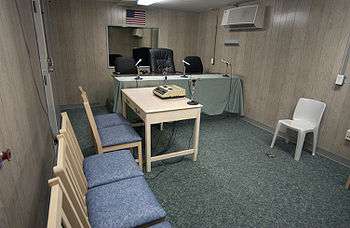Jihad Ahmed Mustafa Dhiab
| Jihad Ahmed Mustafa Dhiab | |
|---|---|
 | |
| Arrested |
November 2001 Pakistan |
| Citizenship | Syrian |
| Detained at | Guantanamo |
| ISN | 722 |
| Charge(s) | No charge, held in extrajudicial detention |
| Status | granted asylum in Uruguay, current location: Medical Union of Uruguay[1] |
Jihad Ahmed Mujstafa Diyab also known as Abu Wa'el Dhiab[2] was born in Lebanon. He was held in extrajudicial detention in the United States' Guantanamo Bay detention camp, in Cuba until he was released to Uruguay.[3] His Guantanamo Internment Serial Number was 722. Dhiab was one of the Guantanamo hunger strikers,[4] and there were fears he would die in custody when his weight dropped to dangerously low levels.
He, along with other 5 Guantanamo prisoners, was granted asylum by Uruguay in exchange for a trade agreement to allow Uruguay to sell oranges to the US.[5] On December 7, 2014, he was released to Uruguay.
Capture
Dhiab was captured in Lahore, Pakistan, in 2002, and taken to the U.S. detention facility at Guantánamo Bay, Cuba. While U.S. officials stated that he had links to militants, he was never charged. Dhiab spent 12 years at the facility, where he went on hunger strikes to protest his detention.[4]
Wife
His wife, Yusra al-Hussein, was apprehended and held in extrajudicial detention in Syria in July 2008.[6] Amnesty International reports she was released on July 22, 2009.[7] Amnesty suspects she was taken into custody for trying to contact human rights groups for help lobbying for Diyab's release from Guantanamo.
Official status reviews
Originally the Bush Presidency asserted that captives apprehended in the "war on terror" were not covered by the Geneva Conventions, and could be held indefinitely, without charge, and without an open and transparent review of the justifications for their detention.[8] In 2004 the United States Supreme Court ruled, in Rasul v. Bush, that Guantanamo captives were entitled to being informed of the allegations justifying their detention, and were entitled to try to refute them.
Office for the Administrative Review of Detained Enemy Combatants

Following the Supreme Court's ruling the Department of Defense set up the Office for the Administrative Review of Detained Enemy Combatants.[8][11]
A Summary of Evidence memo was prepared for his Combatant Status Review Tribunal on 2004-09-25.[12] The memo listed nine allegations:
The Summary of Evidence memos prepared for his 2005, 2006, 2007 and 2008 Administrative Review Board hearings have been published.[13][14][15][16] Among the allegations he faced were:
- that he had hosted Abu Musab Al Zarqawi to stay in his house;
- that he was an expert forger;
- that he was a member of Asbat Al Ansar;
- that he had wanted to attend the Khalden training camp, but attended the Khandahar airport camp instead;
- some senior al Qaida members resented his assumption that he could attend an al Qaida camp without being vetted;
- some senior al Qaida members were suspicious of him because of his ties to takfiris;
Habeas corpus petition
Diyab had a writ of habeas corpus petition filed on his behalf.[17] The Military Commissions Act of 2006 mandated that Guantanamo captives were no longer entitled to access the US civil justice system, so all outstanding habeas corpus petitions were stayed.[18] On June 12, 2008 the United States Supreme Court ruled, in Boumediene v. Bush, that the Military Commissions Act could not remove the right for Guantanamo captives to access the US Federal Court system. And all previous Guantanamo captives' habeas petitions were eligible to be re-instated. The judges considering the captives' habeas petitions would be considering whether the evidence used to compile the allegations the men and boys were enemy combatants justified a classification of "enemy combatant".[19]
Formerly secret Joint Task Force Guantanamo assessment
On April 25, 2011, whistleblower organization WikiLeaks published formerly secret assessments drafted by Joint Task Force Guantanamo analysts.[20][21] His Joint Task Force Guantanamo assessment was drafted on April 21, 2008.[22] It was signed by camp commandant
Release and post-release activities
On December 7, 2014, he was released to Uruguay.
On June 18, 2016, it was reported that his location was unknown.[4] On June 27, 2016 he went to the Uruguayan Embassy in Caracas, Venezuela. He asked the Uruguayan government to help him go to Turkey to be with his family and stated he did not want to return to Uruguay.[23]
On July 1, 2016, a representative for the Colombia-based Avianca Airlines in São Paulo, Brazil confirmed that an alert had been issued to internal employees asking employees to be on the lookout and report any sightings of Dhiab.[24]
On September 9, 2016 it was reported that Dhiab was on a hunger strike, at his apartment in Montevideo, Uruguay and that his health was deteriorating. A Uruguayan official stated they were trying to find "another country to take Dhiab".[25] On September 14, 2016 a doctor in Uruguay stated that Abu Wa'el Dhiab "was unconscious" and had slipped into a coma due to a prolonged hunger strike and that it was hard to tell if "it was reversible".[1]He was given medical treatment, came out of the coma, then continued his hunger strike.[26]
On December 17, 2016 he was deported back to Uruguay from South Africa after trying to enter this country as a tourist. [27]
On July 24, 2017 he was once again deported back to Uruguay from Morocco. He entered Morocco with a false Tunisian passport, once more he stated that he wants to join his family in Turkey. [28]
References
- 1 2 Fox, Ben; Habercorn, Leonardo (September 14, 2016). "Doctor: Hunger-striking ex-Gitmo prisoner slips into coma". Associated Press. Retrieved 15 September 2016.
- ↑ "South Africa turns away former hunger-striking Guantánamo detainee". Miami Herald. 16 December 2016.
- ↑ "List of Individuals Detained by the Department of Defense at Guantanamo Bay, Cuba from January 2002 through May 15, 2006" (PDF). United States Department of Defense. Retrieved 2006-05-15.
- 1 2 3
Carol Rosenberg (June 17, 2016). "Former Guantánamo hunger striker sent to Uruguay may have gone to Brazil". Miami Herald. Archived from the original on June 18, 2016. Retrieved 2016-06-18.
Law enforcement is now searching for former detainee Abu Wa'el Dhiab in Brazil. A Syrian national, he is sometimes also identified as Jihad Ahmed Mustafa Dhiab.
- ↑ https://www.elobservador.com.uy/mujica-para-venderle-unos-kilos-naranja-eeuu-me-tuve-que-bancar-cinco-locos-guantanamo-n906866
- ↑ "Amnesty hails release of Syrian prisoner". United Press International. July 22, 2009. Retrieved 2009-07-22.
- ↑ "Wife of Guantánamo detainee released in Syria". Amnesty International. July 22, 2009. Retrieved 2009-07-22.
- 1 2
"U.S. military reviews 'enemy combatant' use". USA Today. October 11, 2007. Archived from the original on August 11, 2012.
Critics called it an overdue acknowledgment that the so-called Combatant Status Review Tribunals are unfairly geared toward labeling detainees the enemy, even when they pose little danger. Simply redoing the tribunals won't fix the problem, they said, because the system still allows coerced evidence and denies detainees legal representation.
- ↑ Guantánamo Prisoners Getting Their Day, but Hardly in Court, New York Times, November 11, 2004 – mirror Archived September 30, 2007, at the Wayback Machine.
- ↑ Inside the Guantánamo Bay hearings: Barbarian "Justice" dispensed by KGB-style "military tribunals", Financial Times, December 11, 2004
- ↑ "Q&A: What next for Guantanamo prisoners?". BBC News. January 21, 2002. Archived from the original on November 24, 2008. Retrieved 2008-11-24.
- ↑ OARDEC (September 25, 2004). "Summary of Evidence for Combatant Status Review Tribunal – Diyab, Jihad Ahmed Mujstafa" (PDF). United States Department of Defense. pp. 91–92. Archived from the original (PDF) on May 10, 2008. Retrieved November 18, 2008.
- ↑ OARDEC (October 13, 2005). "Unclassified Summary of Evidence for Administrative Review Board in the case of Deyab, Jihad Ahmed Mujstafa". United States Department of Defense. Retrieved 2009-07-22.
- ↑ OARDEC (June 26, 2006). "Unclassified Summary of Evidence for Administrative Review Board in the case of Deyab, Jihad Ahmed Mustafa". United States Department of Defense. Retrieved 2009-07-22.
- ↑ OARDEC (July 2, 2007). "Unclassified Summary of Evidence for Administrative Review Board in the case of Jihad Deyab". United States Department of Defense. Retrieved 2009-07-22.
- ↑ OARDEC (September 11, 2008). "Unclassified Summary of Evidence for Administrative Review Board in the case of Deyab, Jihad" (PDF). Guantanamo: United States Department of Defense. p. 217. Archived (PDF) from the original on August 11, 2012. Retrieved 2016-06-19.
- ↑ Zachary Katznelson (July 18, 2008). "Guantanamo Bay Detainee Litigation: Doc 121 – STATUS REPORT" (PDF). United States Department of Justice. Retrieved 2008-11-17.
- ↑ Peter D. Keisler, Douglas N. Letter (October 16, 2006). "NOTICE OF MILITARY COMMISSIONS ACT OF 2006". United States Department of Justice. Archived from the original (PDF) on September 30, 2008. Retrieved 2008-09-30.
- ↑ Farah Stockman (October 24, 2008). "Lawyers debate 'enemy combatant'". Boston Globe. Archived from the original on October 24, 2008. Retrieved 2008-10-24.
- ↑
Christopher Hope; Robert Winnett; Holly Watt; Heidi Blake (April 27, 2011). "WikiLeaks: Guantanamo Bay terrorist secrets revealed – Guantanamo Bay has been used to incarcerate dozens of terrorists who have admitted plotting terrifying attacks against the West – while imprisoning more than 150 totally innocent people, top-secret files disclose". The Telegraph (UK). Archived from the original on July 13, 2012. Retrieved July 13, 2012.
The Daily Telegraph, along with other newspapers including The Washington Post, today exposes America's own analysis of almost ten years of controversial interrogations on the world's most dangerous terrorists. This newspaper has been shown thousands of pages of top-secret files obtained by the WikiLeaks website.
- ↑ "WikiLeaks: The Guantánamo files database". The Telegraph (UK). April 27, 2011. Archived from the original on June 26, 2015. Retrieved 2012-07-10.
- ↑ "Jihad Ahmed Mustafa Diyab: Guantanamo Bay detainee file on Jihad Ahmed Mustafa Diyab, US9LE-000722DP, passed to the Telegraph by Wikileaks". The Telegraph (UK). April 27, 2011. Retrieved 2016-06-19.
- ↑ "Cancillería informó que exrecluso de Guantánamo no quiere volver a Uruguay". El Observador. July 27, 2016.
- ↑ Savarese, Mauricio; Habercorn, Leonardo. "South American airline issues alert on former Gitmo detainee" (July 4, 2016). Associated Press. Retrieved 15 September 2016.
- ↑ "Hunger-striking Gitmo ex-detainee's health said to worsen". Associated Press. September 9, 2016. Retrieved 15 September 2016.
- ↑ Haberkorn, Leonardo (19 September 2016). "Uruguay rejects demand by hunger-striking ex-Gitmo detainee". Associated Press. Retrieved 25 September 2016.
- ↑ "Diyab fue deportado por Sudáfrica y regresa a Uruguay". El Observador. December 17, 2016.
- ↑ "Exrecluso de Guantánamo volvió a Uruguay luego de ser deportado en Marruecos". El Observador. July 24, 2017.
External links
- Who Are the Remaining Prisoners in Guantánamo? Part Seven: Captured in Pakistan (3 of 3) Andy Worthington, October 13, 2010